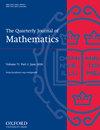密集除数整数的埃尔德斯-卡克定理
IF 0.5
4区 数学
Q3 MATHEMATICS
引用次数: 0
摘要
我们证明,对于大整数 n(其连续除数之比受一个任意常数的约束),质因数的个数遵循近似正态分布,其均值为 $C \log_2 n$,方差为 $V \log_2 n$,其中 $C=1/(1-{\rm e}^{-\gamma})约为 2.280$,V ≈ 0.414。这一结果将在两个不同的方向上得到推广。本文章由计算机程序翻译,如有差异,请以英文原文为准。
An ErdŐs–Kac theorem for integers with dense divisors
We show that for large integers n, whose ratios of consecutive divisors are bound above by an arbitrary constant, the number of prime factors follows an approximate normal distribution, with mean $C \log_2 n$ and variance $V \log_2 n$, where $C=1/(1-{\rm e}^{-\gamma})\approx 2.280$ and V ≈ 0.414. This result is then generalized in two different directions.
求助全文
通过发布文献求助,成功后即可免费获取论文全文。
去求助
来源期刊
CiteScore
1.30
自引率
0.00%
发文量
36
审稿时长
6-12 weeks
期刊介绍:
The Quarterly Journal of Mathematics publishes original contributions to pure mathematics. All major areas of pure mathematics are represented on the editorial board.

 求助内容:
求助内容: 应助结果提醒方式:
应助结果提醒方式:


